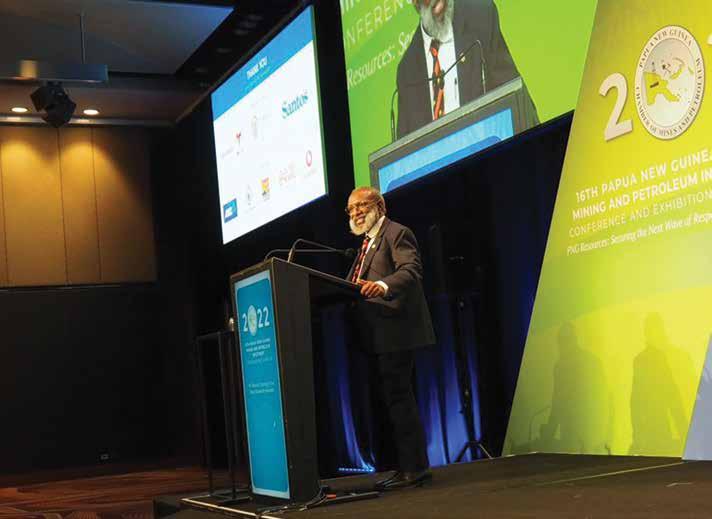
4 minute read
Kerenga Kua on planned petroleum and gas reforms
PNG is planning to move to a production sharing regime for petroleum and gas by the middle of the decade. BusinessAdvantagePNG caught up with Minister for Petroleum, Kerenga Kua, to better understand why the reforms are happening, and what industry can expect.
Business Advantage PNG (BAPNG):
The Marape government has flagged its desire to have a new regulatory framework for petroleum and gas by 2025. What do you expect the reforms to address?
The Hon. Kerenga Kua MP (Kua): Ultimately, we want to remove some of the pain and mischief the current regime is labouring under, while also bringing about greater benefits.
BAPNG: Where do you see most of the pain and mischief within the existing framework?
Kua: Under the current scheme, we are effectively giving mining and petroleum resources away for free and borrowing to buy them back. Then, there is the requirement for the State to contribute to construction costs, which requires further borrowing.
There are already two huge loans
Kerenga
Minister of Petroleum
sitting on the State’s shoulders, which need to be serviced for many years, before these projects start returning revenue.
The dilemma is twofold: our people don’t accept that we’re paying loans and receiving no immediate revenue on resources we’re supposed to own. As a government, we don’t have money to frolic around in commercial enterprises, especially when more immediate pressures must be addressed, including infrastructure, education, healthcare and law and order.
BAPNG: Exactly how will the policy landscape change?
Kua: Taking the State out of the dilemma means leaving the investment cost to the investors. While the State will get its normal royalty, development levies, and taxes, every project will be based on its own dynamics.
Industry had until February 2023 to make submissions to the proposed Bill before Parliament, and we expect a final draft two months later, which should go before Parliament by mid2023.
BAPNG: What’s your message to investors now?
Kua: First, the reform we’re talking about isn’t really focused on them per se; it’s focused on rescuing the State from its own dilemma.
Second, when it comes to sharing the benefits of a project, that will now be a matter for contract negotiation. We will have some minimum prescriptions, as we already do for the development levy and royalty, but we cannot prescribe on taxes.
Third, within the new regime, we expect the first cab off the rank for investors to be the recovery of royalties and development levies. Only then will the developers be able to take their cost of production out.
Once costs and margins are dealt with, profit is where the big negotiations will take place and, when it comes to profit oil, the State will expect a bigger share going forward.
Overall, investors shouldn’t be alarmed by our transition from a post-World War II concession-based licensing system to production sharing arrangements. Investors can continue their activity, based on what drives their financial investment decisions.
BAPNG: It’s nearly a decade since PNG became an LNG-producing nation. How has this helped the country?
Kua: Without mining and without LNG, PNG would not have made all the economic progress, development and improved livelihoods that we have done. While we have a lot of problems and issues, we cannot bury the remarkable progress we’ve made.
If any credit is to be shared, we must all share it together: governments, companies and the people.
PNG’S LNG ROADMAP
The outlook for PNG’s gas sector looks positive, as LNG continues to displace coal as an energy source globally.
Projections by ExxonMobil, which runs PNG’s first gas project, PNG LNG, suggest LNG demand will double up to 2050, with 90 per cent of additional demand coming from Asia, PNG’s gas marketplace.
‘Natural gas continues to provide a reliable and flexible fuel and will remain important as the world drives to decrease greenhouse gas emissions,’ Peter Larden, Managing Director of ExxonMobil PNG told the 2022 PNG Investment Conference.

In 2022, as global demand for gas and prices surged, the PNG LNG project broke its daily production record. While National Budget projections suggest that surge is over, the investment pipeline for gas in PNG looks solid.
A gas agreement for the ExxonMobil-led US$10 billion P’nyang project in Western Province was executed between the State and project partners ExxonMobil (49 per cent), Santos (38.5 per cent) and JX Nippon (12.5 per cent) in February 2022. While a final investment decision is some years away, construction of P’nyang has been scheduled to commence after TotalEnergies’ Papua LNG project (see page 22) is completed, most likely in 2028.
State-owned Kumul Petroleum is expected to take up the State’s 22.5 per cent stake in the project, as allowed by law, with the other parties’ stakes diluting.
Like Papua LNG, P’nyang – which holds an estimated 4.4 trillion cubic feet of gas – is expected to use ExxonMobil’s existing downstream facilities at Caution Bay outside Port Moresby to prepare its gas for export.
Nearer term, ExxonMobil has also been looking to add additional gas from within the existing PNG LNG project footprint. The K5.5 billion development of its Angore gas field restarted in 2022, with production due in 2024.
‘We’ve seen dramatic market shifts both in terms of price and demand. It’s more important than ever that we stay focused in delivering affordable and reliable energy,’ says Larden.
Meanwhile, Australia’s Santos greatly increased its footprint in PNG through its merger with Oil Search in late 2021. While Kumul Petroleum’s binding offer to acquire five per cent of the PNG LNG project from Santos was in play at the time of writing, Santos is expected to have a major role in Papua LNG and P’nyang, and has flagged its intention to extend the life of PNG’s only productive oil fields, Gobe and Kutubu.









